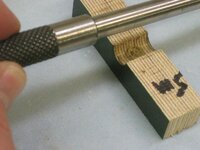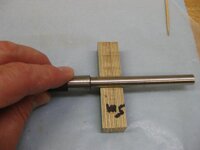ldb2000
Member
After reading about one persons problem with some snakeskin blanks I'm posting this to answer some questions that some may have about these types of blanks (embedded materials blanks , like circuit board , shell , snakeskin , label/photo blanks) . This mainly applies to PR for the first part but all other types of resin for the second part . Remember we are doing things with these types of blanks that the resin really wasn't designed for and as such there can be occasional problems .
One , Polyester resin blanks have a sticky surface to them as part of the design of the resin . This allows any further pours of resin to stick to the surface better then fully cured resin . This sticky surface can be avoided by either post curing the blanks for an hour or more in a low temperature oven at the expense of creating a more brittle blank , or adding a surfacing agent (styrene/wax mixture) . The sticky surface has no negative effect on the blanks other then being sticky and can be turned off without any worries .
Two , Tubes pushing out . The cast object (snake skin , shell , circuit board ... ) has to be stuck to the tube by some method . This means it must be glued to the tube by some method . most glues are softened by heat and in casting there is heat created by the curing of the resin and post curing (if done) . This heat can break the glue bond to the tube causing the tube to break loose . While annoying this can be easily repaired by simply putting a couple of drops of thin CA on the ends of the blank and allowing it to soak in . Also using a barrel trimmer can cause enough heat by friction to break the glue bond to the tube causing the same problem . I always advise using a sanding of the ends rather then barrel trimmers on any cast embedding blanks to avoid the heat problems .
Three , Turning these types of blanks presents another problem . The thickness of the resin over the embedded object can get very thin on certain types of pen kits . Sierras are very popular kits but the thickness of the blank can be very thin and the embedded objects can be very close to the surface of the blank . Sierra Vista's or Wall St III's are the best choice for these types of blanks . Regular Sierra's can be used but special care has to be used in these situations . The phrase "Very light cuts" is used allot around here but in cases of embedded object blanks it is even more important . On a normal Sierra kit there is only a very small amount of blank to begin with at the ends of the blanks and when you add something like a circuit board , that covering of resin is even thinner . If you are not very careful and taking very , very light cuts you can easily tear away the resin from the covering of the embedded object . This requires techniques that take lots of practice with a skew to master . A gouge or carbide cutter tool is way too aggressive to safely turn the very thin resin covering on these blanks and if you try and use these tools you will most likely fail . I'm not going to argue that some have done this with gouges or carbide cutting tools because it can be done but chances are good that you will tear out some resin in most cases . These are great tools for turning down a blank but when the resin gets this thin only a skew or specially tuned scraper can safely do this type of cut .
I hope this answers some questions and helps you become more successful on turning this type of blank .
One , Polyester resin blanks have a sticky surface to them as part of the design of the resin . This allows any further pours of resin to stick to the surface better then fully cured resin . This sticky surface can be avoided by either post curing the blanks for an hour or more in a low temperature oven at the expense of creating a more brittle blank , or adding a surfacing agent (styrene/wax mixture) . The sticky surface has no negative effect on the blanks other then being sticky and can be turned off without any worries .
Two , Tubes pushing out . The cast object (snake skin , shell , circuit board ... ) has to be stuck to the tube by some method . This means it must be glued to the tube by some method . most glues are softened by heat and in casting there is heat created by the curing of the resin and post curing (if done) . This heat can break the glue bond to the tube causing the tube to break loose . While annoying this can be easily repaired by simply putting a couple of drops of thin CA on the ends of the blank and allowing it to soak in . Also using a barrel trimmer can cause enough heat by friction to break the glue bond to the tube causing the same problem . I always advise using a sanding of the ends rather then barrel trimmers on any cast embedding blanks to avoid the heat problems .
Three , Turning these types of blanks presents another problem . The thickness of the resin over the embedded object can get very thin on certain types of pen kits . Sierras are very popular kits but the thickness of the blank can be very thin and the embedded objects can be very close to the surface of the blank . Sierra Vista's or Wall St III's are the best choice for these types of blanks . Regular Sierra's can be used but special care has to be used in these situations . The phrase "Very light cuts" is used allot around here but in cases of embedded object blanks it is even more important . On a normal Sierra kit there is only a very small amount of blank to begin with at the ends of the blanks and when you add something like a circuit board , that covering of resin is even thinner . If you are not very careful and taking very , very light cuts you can easily tear away the resin from the covering of the embedded object . This requires techniques that take lots of practice with a skew to master . A gouge or carbide cutter tool is way too aggressive to safely turn the very thin resin covering on these blanks and if you try and use these tools you will most likely fail . I'm not going to argue that some have done this with gouges or carbide cutting tools because it can be done but chances are good that you will tear out some resin in most cases . These are great tools for turning down a blank but when the resin gets this thin only a skew or specially tuned scraper can safely do this type of cut .
I hope this answers some questions and helps you become more successful on turning this type of blank .


